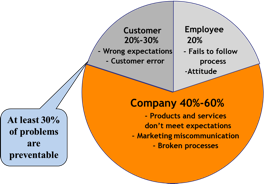
Get your FREE 30-day trial.
Please complete all fields.
Almost all service executives and call center directors spend most of their management time focused on the front line customer service representatives (CSRs). While this may seem logical, it is based on the incorrect supposition that the CSR is the primary cause of customer dissatisfaction. In fact, my analysis of data from several hundred service operations is that, at most, 20 percent of dissatisfaction is due to CSRs misbehaving, e.g. attitude, sloppiness, errors, failing to follow proscribed policy. A much greater percentage is caused by the CSR delivering service exactly as mandated by management – it is just that such service and policies do not leave the customer satisfied. This is not the CSRs fault, it is management’s fault.
Across all industries, I have found the following figure is a good portrayal of the cause of customer dissatisfaction.

There are four broad causes of dissatisfaction. The specific allocations vary by industry:
Most companies allocate the bulk of their survey and monitoring resources to identifying the performance of every CSR. This is done by doing random sample surveys of all contacts. The first problem is that the CSR is not the cause of most dissatisfaction. The second problem is that 70-80 percent of all contacts are so simple anyone could handle them and you are not learning anything from either listening to the call or surveying the customer (while you are creating extra survey burden on the customer).
A better approach to allocation of survey, monitoring and analytical resources is as follows:
Analyze your survey data by type of issue. You will find 70 percent of issues are consistently resolved by all reps. Identify the five issues where, regardless of CSR, the customer is less than satisfied. These are issues where the response rule or process are not effective.
Ask your CSRs for the top five types of contacts that are preventable if marketing communicated more effectively and/or customers were better educated. You will find that just those five issues probably are responsible for at least 10 percent of your workload. Identify how marketing and website resources could be modified to more properly set expectations and reduce those contacts.
As you modify response rules and processes as well as marketing and customer education processes, communicate to the front line so they have hope and see that their input is being used. I find that newsletters posted in bathrooms cut through filtering by supervisors. Two of our clients have named such newsletters, ‘Flush Facts” and “ The Stall Street Journal.”
The company’s website must be reoriented to balance education and support with traditional marketing and sales activities. Education, support, expectation setting and a new customer orientation portal should all be featured prominently on the home page – not three clicks inside.
Educate the marketing and sales departments that proactive communication is a delighter and that setting proper customer expectations will create long-term loyalty.
Achieving each of these prerequisites is an ongoing journey, not a quick action.
John Goodman is Vice Chairman of Customer Care Measurement & Consulting, jgoodman@customercaremc.com, Twitter jgoodman888. His new book, Customer Experience 3.0 was published in May of 2014. AMACOM also published his first book, Strategic Customer Service.
Want to provide customer service that not only meets your customers' expectations, but exceeds them? Download the free Salesforce e-book.